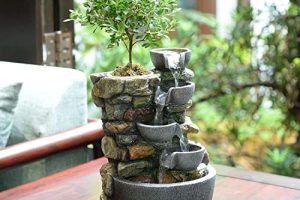Enhance Your Wellbeing with the Soothing Sounds of an Indoor Fountain

Introduction to Indoor Fountains
Indoor fountains are swiftly becoming a popular addition to home decor, bringing not just visual appeal but also a myriad of benefits. They create a serene atmosphere that promotes relaxation and adds a touch of nature to indoor environments. However, choosing the right fountain can lead to an enriched living space, fostering both aesthetic beauty and a calming ambiance.
- Enhance Your Wellbeing with the Soothing Sounds of an Indoor Fountain
- Introduction to Indoor Fountains
- Benefits of Indoor Fountains
- Popular Types of Indoor Fountains
- Health Benefits of Indoor Fountains
- Stress Reduction
- Improved Air Quality
- Choosing the Right Indoor Fountain for Your Space
- Size and Placement
- Types of Water Features
- Installing Your Indoor Fountain
- DIY Installation Tips
- Maintenance and Care Tips
- Enhancing Your Home Decor with Indoor Fountains
- Styling Tips
- Feng Shui and Indoor Fountains
Benefits of Indoor Fountains
There are countless advantages to incorporating indoor fountains into various spaces, whether it’s a cozy living room, tranquil bedroom, or even a professional office. Here are a few key benefits:
- Aesthetic Appeal: Indoor fountains act as stunning focal points. The movement of water introduces dynamic visuals that can liven up any room.
- Sound of Water: The soothing sound of flowing water can mask unpleasant noises, creating a peaceful environment conducive to relaxation and concentration.
- Humidity Control: Fountains increase indoor humidity levels, which can be particularly beneficial in dry climates. This helps in reducing respiratory distress and skin dryness.
- Natural Air Purification: As water flows, it can help to trap dust and other impurities, contributing to cleaner air.
Drawing from personal experience, adding a small tabletop fountain to my office space transformed the atmosphere. The gentle trickle of water not only elevated the decor but also helped in boosting my focus during long work hours.
Popular Types of Indoor Fountains
Indoor fountains come in various styles and sizes, making it easy to find one that suits personal taste and spatial constraints. Here are some popular options:
- Wall Fountains: Mounted on walls, these fountains save floor space while providing a striking visual element.
- Tabletop Fountains: Perfect for small spaces, these can sit on desks or shelves, adding a touch of tranquility without overwhelming the surroundings.
- Freestanding Fountains: These larger options can serve as bold statements in spacious areas, filling corners with their grandeur.
- Bubbler Fountains: Often placed in gardens or on patios, these fountains create gentle bubbles on the surface, imbuing a playful atmosphere.
Overall, the introduction of an indoor fountain offers a diverse range of benefits and aesthetics that can enhance living and working environments significantly.
Health Benefits of Indoor Fountains
Indoor fountains are not just decorative elements; they can significantly enhance well-being in both physical and mental aspects. They offer unique health benefits, making them a worthwhile investment for any home or office. Let’s delve deeper into how these soothing water features can help foster a healthier lifestyle.
Stress Reduction
One of the most appreciated benefits of indoor fountains is their ability to reduce stress. The calming sound of water flowing creates a tranquil atmosphere that encourages relaxation. Here are a few ways indoor fountains can help mitigate stress:
- Nature’s Soundtrack: The gentle trickle of water serves as nature’s white noise, helping to drown out distracting sounds and create a peaceful ambiance.
- Mindfulness and Meditation: Sitting by a fountain encourages mindfulness. It can serve as a focal point during meditation or yoga practices, enabling a deeper state of relaxation.
- Enhanced Mood: The presence of water and the visuals of cascading fountains can uplift the spirit, promoting positive emotions and reducing anxiety levels.
I’ve found that spending just a few moments near my tabletop fountain during a hectic day instantly calms my mind and helps me refocus.
Improved Air Quality
Indoor fountains also contribute to better air quality, an essential factor for overall health. They do this in several ways:
- Increased Humidity: Fountains naturally increase humidity in the air, relieving dryness that can lead to respiratory issues and skin irritations. This is especially beneficial in dry climates or during the winter months.
- Dust and Allergy Reduction: As water flows, it can filter out dust particles, dander, and other allergens from the air, creating a cleaner indoor environment.
- Negative Ions: Water movement generates negative ions, which can improve mood and promote overall well-being while helping combat fatigue.
In my experience, since incorporating a larger freestanding fountain into my living room, I’ve noticed a decrease in dust accumulation, which has positively impacted my allergies. In summary, the health benefits of indoor fountains extend far beyond mere decoration. They play a crucial role in reducing stress and enhancing air quality, making every day a little brighter and healthier.
Choosing the Right Indoor Fountain for Your Space
Now that we’ve explored the multitude of health benefits that indoor fountains offer, it’s crucial to consider how to choose the right one for your specific space. The size, placement, and type of fountain can significantly influence how effectively it enhances your environment.
Size and Placement
When selecting an indoor fountain, size and placement should be your first considerations, as they directly impact the fountain’s effectiveness and aesthetic appeal. Here are some tips to keep in mind:
- Assess Your Space: Measure the area where you plan to place the fountain. Consider the dimensions carefully. A large freestanding fountain might overwhelm a small room, while a miniature tabletop fountain could get lost in a spacious office.
- Visual Balance: Make sure the fountain complements your existing furniture and decor. For example, a tall wall fountain can work well in a room with high ceilings, while smaller fountains are perfect for more intimate settings.
- Natural Light: Place the fountain in a location where it can receive some natural light. This not only enhances the visuals but also supports any plants you might want to incorporate with the fountain.
In my own experience, placing a medium-sized wall fountain in my hallway created an inviting entrance that sets a calming tone as soon as guests arrive.
Types of Water Features
With many types of indoor fountains available, it’s essential to choose one that resonates with your style and purpose. Here are the most popular types:
- Wall Fountains: Ideal for saving floor space while giving visual height. Perfect for entryways or offices.
- Tabletop Fountains: These compact options are fantastic for desks or shelves, providing a peaceful escape without taking up too much space.
- Floor Fountains: Great for creating a statement in larger spaces like living rooms or open areas, where they can serve as a focal point.
- Bubblers: Typically smaller, these feature gentle bubbles and can add a playful touch to any decor, ideal for bookshelves or window sills.
- Spout Fountains: Mimicking traditional styles, spout fountains can have a rustic or classical look that brings charm to indoor gardens or patios.
Ultimately, the fountain you choose should enhance your personal space while reflecting your individual style. By considering size, placement, and type, you’ll find the perfect indoor fountain that transforms your home into a serene oasis.
Installing Your Indoor Fountain
Once you’ve selected the perfect indoor fountain for your space, it’s time to consider installation. While some might opt for professional assistance, many indoor fountains are designed for easy DIY installation. Following that, proper maintenance is essential to keep your fountain in great shape. Let’s explore some helpful tips for both installing and maintaining your indoor fountain.
DIY Installation Tips
Installing an indoor fountain can be a rewarding project. Here are a few pointers to make the process smoother:
- Read Instructions Carefully: Always start by reviewing the manufacturer’s instructions. Each fountain may have unique requirements that could save you time and effort.
- Select a Suitable Location: Ensure that the area is near a power source for electric fountains, and consider access for filling and maintenance. If possible, choose a spot where the sound of flowing water can be enjoyed without distraction.
- Use a Level: If installing a wall-mounted fountain, a level is indispensable for ensuring it hangs straight. An uneven fountain can affect both the look and function.
- Water Source: Most fountains require filling before use. If using a floor fountain, place it where it’s easy to refill or connect to a water supply.
Reflecting on my recent installation of a tabletop fountain, ensuring it was level made a noticeable difference. The perfect balance truly enhanced its aesthetic and effectiveness.
Maintenance and Care Tips
Proper maintenance is crucial to ensure the longevity and functionality of your indoor fountain. Here are some essential care tips:
- Regular Water Checks: Keep the water level consistent by checking it weekly. If the water evaporates quickly, consider running the fountain at a lower setting to mitigate loss.
- Cleaning: Clean the fountain at least every two weeks. Use a soft cloth and non-abrasive cleaners, as harsh chemicals can harm the fountain materials. Occasionally, a vinegar solution can help remove mineral deposits.
- Pump Maintenance: Maintain the fountain’s pump by checking it for debris or blockages. Clean the pump as per the manufacturer’s instructions to ensure optimal performance.
- Algae Prevention: Adding a few drops of aquarium-safe algae treatment can help prevent algae buildup, especially in large water features.
By following these installation and maintenance tips, your indoor fountain can become a beautiful centerpiece in your home, providing tranquility and enjoyment for years to come. The effort put into installing and maintaining it will undoubtedly enhance the ambiance and health benefits it brings to your living space.
Enhancing Your Home Decor with Indoor Fountains
Having explored the practical aspects of installing and maintaining indoor fountains, let’s delve into the aesthetic side and see how these beautiful features can enhance your home decor. Indoor fountains not only serve a functional purpose but can also be artistic expressions that elevate your space. Here, we’ve compiled some styling tips and insights into how feng shui principles can guide your fountain placement.
Styling Tips
Integrating an indoor fountain into your home decor can be a lovely way to create focal points and harmonize your interior design. Here are some effective styling tips:
- Choose the Right Style: Match the fountain style with your existing decor. For example, a sleek, modern wall fountain complements contemporary designs, while a rustic stone fountain would suit a more traditional or farmhouse style.
- Create Levels: Position the fountain at different heights—such as on a pedestal or alongside greenery. This adds dimension and draws the eye through the space. A small fountain at a lower level surrounded by plants can create a serene nook.
- Accessorize: Pair your fountain with plants, candles, or decorative stones for added flair. Surrounding your fountain with lush greenery enhances the natural feel and creates a tranquil setting.
- Lighting Effects: Consider adding soft lighting around your fountain. Underwater LED lighting can create captivating reflections and highlight the water’s movement during the evening hours.
From my experience, adding fairy lights to the base of my tabletop fountain transformed its appearance at night, making it a magical centerpiece for gatherings.
Feng Shui and Indoor Fountains
Feng Shui, the ancient Chinese art of creating harmony in living spaces, emphasizes the importance of water features in promoting positive energy flow. Here are some foundational principles to consider when incorporating a fountain into your home according to Feng Shui:
- Location Matters: Ideally, place your fountain in the living room, entryway, or a study. These areas benefit from the calming effects of flowing water and positively influence family interactions and productivity.
- Focus on Flow: Ensure that the water flows towards the interior of your home, symbolizing the influx of wealth and good luck. Conversely, if the water flows out of the house, it may represent energy (or fortune) flowing away.
- Colors and Materials: Incorporate elements that resonate with your desired energy. For example, a fountain with natural stone will contribute grounding energy, while metals can enhance creativity and clarity.
By thoughtfully selecting the style and placement of your indoor fountain, you can ensure it enhances not just the visual appeal of your home, but also positively impacts your well-being. Embracing these styling tips and feng shui principles will help you create a peaceful and harmonious environment that invites relaxation and joy.




